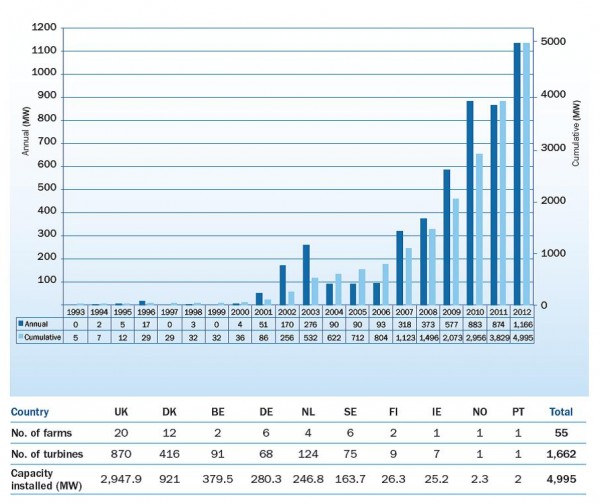A new report from the European Wind Energy Association (EWEA) shows just how far their commitment to offshore wind has taken them, and where they’re headed. Meanwhile, in the United States, no turbines, but progress nonetheless. And in Asia, some notable results.
European seascape
EWEA announced last week that installations in 2012 brought the continent’s total (including the UK) to within spitting distance of 5,000 megawatts (MW).
The EWEA report itself has oodles of information about the range of suppliers, technologies, and physical characteristics to watch. Some tasty tidbits:
- In 2012, four new projects came online, totaling 1,166 MW — one-third more than in 2011.
- That growth brought the total installed capacity in Europe to 4,995 MW — enough to serve millions of European households. That total comes from 1,662 graceful turbines in 55 wind farms in 10 forward-looking countries.
- Another 14 projects got partially completed or got their foundations set in 2012. When those are completed and connected, they’ll add another 3,300 MW, including maybe 1,400 in 2013.
- In all, says EWEA, construction was happening at nine sites, “many of which have held the title of the world’s largest offshore wind farm” — even fleetingly — including Walney (368 MW), Greater Gabbard (504 MW), and London Array (630 MW), all in the UK. The 175th and final turbine in the London Array went up in December.
- That progress allowed the UK to broaden its lead in the offshore wind world, bringing them to almost 3,000 MW of total installations. Denmark holds second place with over 900 MW.
Lots of progress.

What growth looks like: European offshore wind installations, annual (left axis) and total (right), and how it stacks up by country (bottom) (Source: EWEA)

Where the wild turbines are: water depth and distance to shore for European offshore wind projects that are online, under construction, or forthcoming (“consented”) (Source: EWEA)
Meanwhile, back at the ranch…
The U.S. has yet to get any turbines in the water, but this country hasn’t been idle, either. In just the last three weeks:
- The Maine Public Utilities Commission approved a 20-year contract between a developer (Statoil) and a Maine utility for four floating wind turbines to be anchored on the seabed in federal waters off the coast. Statoil installed the first such floating wind turbine in the North Sea in 2009.
- New Bedford (MA) Harbor installed some anti-fish barriers, a move that a spokeswoman for the Massachusetts Clean Energy Center said was “the first physical step towards that offshore wind energy future for Massachusetts” and “a great sign of things to come.” New Bedford’s South Terminal is “specifically designed to accommodate the deployment, construction and assembly of offshore wind turbines.”
- North Carolina Governor Pat McCrory, a Republican, voiced his support for federal plans to designate offshore wind areas off the North Carolina coast: “This is an important step to develop North Carolina’s world-class wind energy resources,” he told the relevant government agency, one that will be good for the state’s economy and for the nation’s energy independence.
- An offshore wind “backbone” transmission project announced plans for a first phase, a 189-mile leg off New Jersey — even without offshore wind projects to connect to it.
Not “wet steel,” in the words of Fara Courtney of the U.S. Offshore Wind Collaborative, but noteworthy.
And there’s a whole world out there. While Europe is center stage at this point (with 90 percent of the installed offshore wind capacity), others are sashaying into the limelight, too. Actually, the EWEA report notes, with 510 MW installed, China is the world’s third largest market. More leaping than sashaying.
Keeping those foundations solid
But Europe has been the one to watch for more than two decades. The European experience shows what’s possible when governments commit to technological advancements to improve energy security and the environmental profile of their energy sectors.
Even there, EWEA points to the importance of a strong and stable policy environment, along with favorable market conditions:
“…solid installation figures do not alter the fact that the wind industry is being hit by political and regulatory instability, the economic crisis, the higher cost of capital and austerity.”
Cost reductions would also be useful, and can come from experience and scale. The cost of the four-turbine Maine pilot project, at 27 cents per kilowatt-hour, is considerably higher than the contracts approved between Massachusetts utilities and the 130-turbine Cape Wind project.
But things are happening. And it’s all worth watching.
